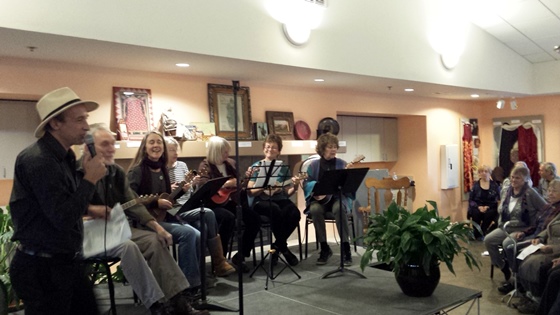||| FROM JANET ALDERTON |||
A letter to our County Councilors: Please think like an engineer and reduce risks by making wise Comprehensive Plan updates.
I think my daughter’s fate to become a civil engineer was sealed by two events:
I left a book titled Why Buildings Fall Down lying around our house when she was 12 years old.
And she was fortunate enough to have a woman civil engineer teach her Advanced Placement physics class in high school. Her teacher’s husband had received a job offer that required them to relocate. As a result of their decision to place his career advancement above hers, my daughter was given a real life female civil engineer as a role model.
Quirkiness evidently runs in my family because my daughter began her essay for admission to the School of Civil Engineering at the University of California Berkeley with a humorous limerick about a civil engineer. She was admitted either because of or despite this limerick — we will never know.
She eventually received a master’s degree in earthquake engineering — also at UC Berkeley.
Having a civil engineer in my family is probably why I keep referring to the “laws of physics” in my comments to you, our county decision makers.
Water flowing downhill over impervious surfaces is something that happens. You can say, “Oh, I would rather not think about it.” But stormwater flows will happen regardless.
As the ultimate decision makers in San Juan County, it is your responsibility to acknowledge risks and reduce their impacts with thoughtful policy and code changes.
Civil engineers design structures and, in my daughter’s case, earthquake and landslide risk reduction plans (funded by the World Bank) for entire countries, using the best available science. The engineering team doesn’t just “consider” the science; they actually “follow” the science.
They design not for “average” risk, but for maximum predictable forces. Then they add extra design measures to avoid catastrophic collapse caused by unpredictable events.
For earthquake and landslide risk reduction, the plans show which places to avoid concentrating development, and especially avoid siting critical infrastructure. Design of individual projects is important in reducing risk as well.
Here is where this applies to San Juan County:
As more and more land is developed, more and more impervious surfaces are created. If we continue “business as usual”, this will predictably result in greater damage from erosion, flooding, and landslides. And less aquifer recharge. Taking peak predicted loads into account in San Juan County would consider peak population during tourist seasons.
And then there is designing for the unexpected — the prolonged extreme drought, for example. Maybe we should call this “expected.”
This is why Alexandra Gayek’s Docket request 21-0008 deserves careful consideration. It addresses how to mitigate the inevitable increase in impervious surfaces that will accompany development in San Juan County.
Alexandra’s suggestions must not only apply to new development; mitigation measures must also be required for existing development. If the new standards are only required for new development, the risk reductions will be too little and too late. Changes must be incorporated into our building codes in addition to just stormwater handing requirements. Building design affects the amount of stormwater produced.
The risks that will be addressed by these code changes are not only erosion, flooding, and landslide risks. The threats to our islands’ water supply will also be reduced. We do not understand the limitations of our aquifers because they have been inadequately studied. But two things are certain: the capacity of our aquifers is limited and their recharge rate depends on slowing stormwater and allowing it to infiltrate our soils. Saltwater intrusion in wells near our shorelines can happen suddenly. The water in these salt-contaminated aquifers is then lost for human use.
Insisting on maintaining the attitude that “San Juan County is different” and that the laws of physics can be ignored is irresponsible.
The increase in our population has accelerated due to the pandemic and due to the perception that San Juan County is a refuge from Climate Change. This “Fortress San Juans” attitude is obviously flawed. You don’t need a precise buildout analysis to recognize that we are resource limited — especially by water.
A Medieval Fortress situated on a hill and surrounded by a moat may seem protected from assault. But a sustained attack would eventually cause the fortress inhabitants to run out of food and water. The combination of accelerated population growth and Climate Change needs to be viewed as just such a threat to our islands’ sustainability.
Please consider adopting Alexandra Gayek’s Docket recommendations. Please also consider adopting the Docket Request 21-0005 from Miles Becker. Forest, shrublands, and grasslands are natural resources that slow stormwater and rainfall and allow our aquifers to recharge.
Please remove the Timber Harvest provision from the Shoreline Master Plan. The “fig leaf” justification for the “science” behind this provision is a Timber Harvest Plan for streamside buffers in Maine. The selective timber harvest in that plan was only allowed when the ground was frozen solid and covered by a thick layer of snow to protect the forest understory plants. How often do these conditions occur in San Juan County? Maybe if we enter a Little Ice Age (unlikely). And is frozen ground and a thick layer of snow required before timber harvest can occur along our shorelines? The answer is no.
No development in the Maine streamside buffers was allowed except for hiking trails. In San Juan County, entire houses, septic drain fields, gardens and orchards, and more, are allowed in the shoreline buffers.
Following the science and “considering” the science are completely different. The Growth Management Act only requires you to consider the science. But wise and responsible leaders will follow the science and also address issues, such as affordable housing, water limitations, and people ignoring the existing regulations, that have been problems for some time. Ferry dysfunction cannot be ignored, either.
Following the science and “considering” the science are completely different.
Please think like a civil engineer and reduce risks with sensible planning and regulations. Please build in resiliency to withstand not only existing and expected challenges, but unexpected as well. And above all, enforce the regulations with consistent and meaningful penalties that will deter our current islands’ culture of “I can do what I want and it will not matter to me personally or to these islands that I love.” When shoreline property owners have built more than 100 structures between the high and low tides over the last 10 years and only 14 of these structures were permitted, you know that something is seriously amiss.
Each violation adds to on-going ecosystem degradation and the loss of what I truly value in both our human and natural communities.









“When shoreline property owners have built more than 100 structures between the high and low tides over the last 10 years and only 14 of these structures were permitted, you know that something is seriously amiss.”
Shocking. And indeed, something is amiss.
In part, the “I can do what I will” attitude is often among persons who do not care whether they risk steep penalties. First of all because, as I have heard, “everybody knows” there is little actual consistent enforcement of regulations in the county (so the risk is low), and secondly because, even if a penalty (even a steep one) were to be exacted, it would be affordable at almost any cost (where wealth abounds), and shrugged off simply as “the cost of doing business” (ie, getting what I want).
Enforcement and penalties need full re-consideration.
Anyone have a reference for this: “When shoreline property owners have built more than 100 structures between the high and low tides over the last 10 years and only 14 of these structures were permitted, you know that something is seriously amiss.”
Thank you, Janet. This is well written and a topic that is on the minds of many locals. I hope the council reads this and heeds your words.
Peg,
The Friends of the San Juans does this survey every 10 years.
It is preliminary, but shocking data.
Janet Alderton,
President of the board of directors, Friends of the San Juans
Ms. Alderton, your general premise that we must mitigate and balance human impacts on the natural world sets a worthy goal. Achieving that goal in a coherent and orderly manner is the challenge.
Integrating human need for sustainable water, food, shelter, sanitation, energy and transportation in accordance with equal and equitable legal principals and economic constraints are topics for thoughtful discussion that would benefit from a systematic engineering approach, as you suggest.
However I believe that enforcement is needed before change can be justified. County requirements are based on very stringent Federal clean water standards, so before “we” demand change or retroactive mitigation it might be wise to assess legal and economic impacts.
Existing conditions are typically “grandfathered” because the prohibition on Ex Post Facto regulation is generally observed by counsel when advising Council, so that may be unachievable. The costs of stormwater mitigation during construction and permanent site stormwater management impact job costs and subsequent housing affordability.
Having recently completed a fully permitted, inspected and certified for occupancy single family residence under IRC 2015 I can attest that achieving required energy efficiency, water quality and stormwater management were significant costs not borne by previously constructed housing, but count myself lucky that I don’t need to comply with the current code which makes the words ‘affordable’ and ‘housing’ appear to be mutually exclusive.
I know that your concerns are genuine, so I put the matter of balance to you.
Phil,
I don’t have all the answers.
You do mention enforcement is needed.
I am 100% with you here.
A buildout population of 132,000 would radically alter our islands.
I hope this is not inevitable.
Ms. Alderton,
I didn’t mean to imply that you had the answers only that you’re approach has the potential to lead us to well reasoned answers that meet myriad stakeholder interests. I don’t know where the 132,000 figure comes from but it’s clearly light years beyond existing resource or infrastructure physical and cost constraints.
Current population I believe is 17,778 far too small to fund future planning for 132,000 so perhaps build-out beyond a sustainable target limit might be based on a (substantial) infrastructure impact development fee that would pay for additional imported or manufactured potable water, expansion of solid waste disposal transfer station / septic solids processing, electrical grid and transportation ferry or bridge build-out. Clearly such a fee would be cost prohibitive for all but the hyper-wealthy, but adding a component for public housing (support for OPAL development) might meet the need for affordable housing and the objectives for expansion imposed by whatever entity may be requiring change.
Alternatively retaining existing land use designations and reinforcing continuing open space, agricultural and forest use to maximum extent may further preservation of the natural / rural ambiance that most of us value and the hyper-wealth may be seeking.
Just thinking out loud here, many thoughts, many stakeholders to be considered in a reasoned approach.
Thank-you for your thoughts, Phil!
Such brainstorming is exactly what we need.
Others are welcome to join the conversation.